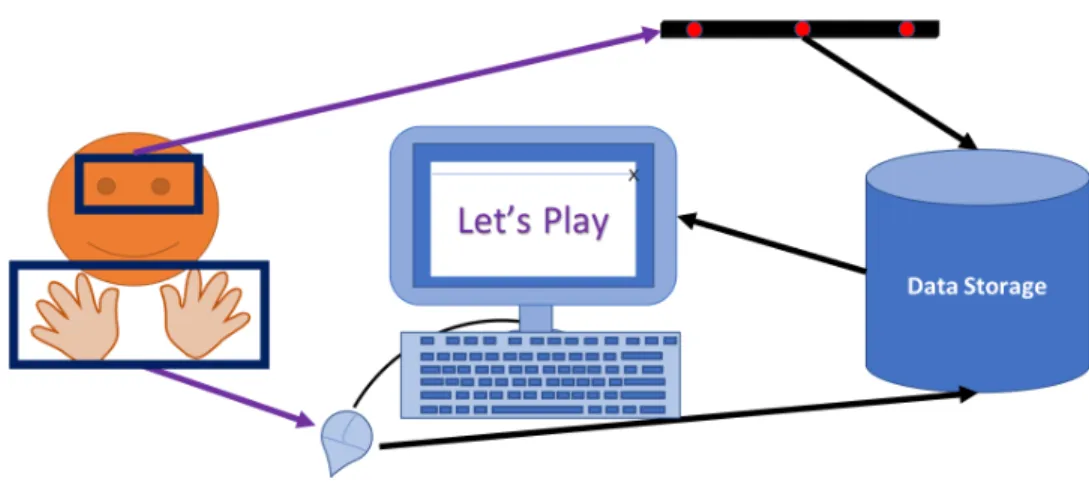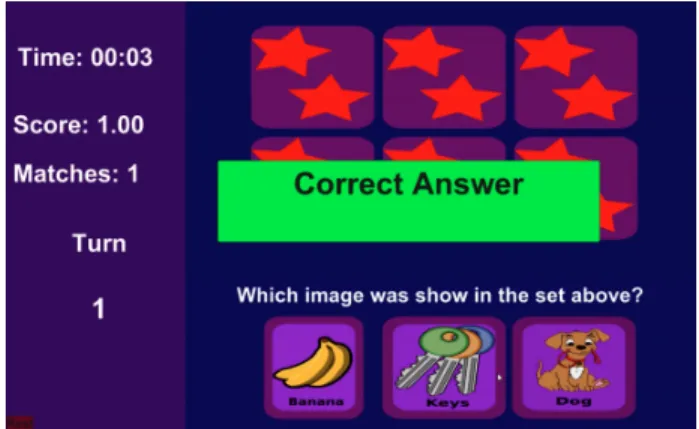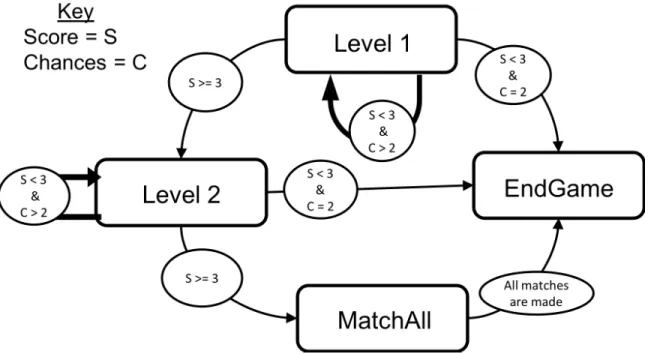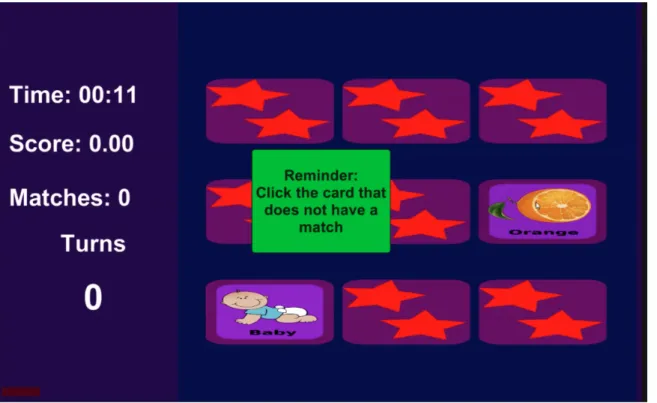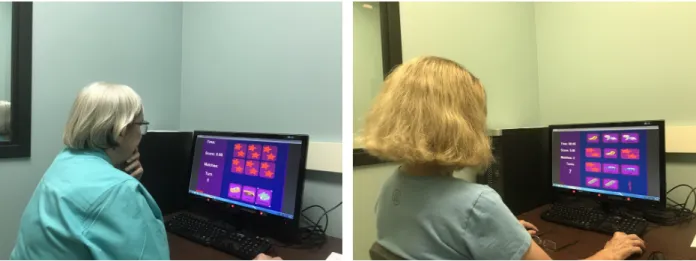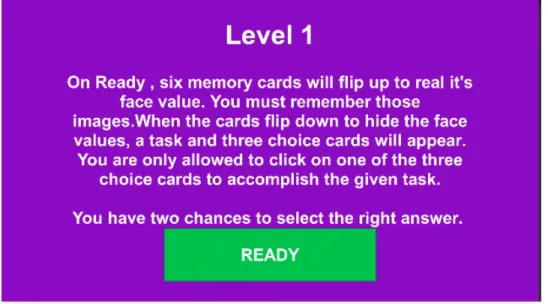This is twelve times the number of older adults living in the United States in 1990. According to the American Association of Retired Persons [2], 90 percent of older adults reported that they wanted to live alone as long as possible.
What is Alzheimers Disease?
In 2010, three percent of older people lived in nursing homes, of the percentage of older people not living in nursing homes, 33 percent (11 million) lived alone, and this number is expected to increase within the next three years [1]. In the early stages of AD and other forms of dementia, approximately 70 percent of these older adults live in long-term senior living communities, with 74 percent of these individuals living with someone and 26 percent living alone [13 ].
Assistive Technology
AD, the most common form of dementia, is a progressive brain disease that causes long-term memory loss, confusion, irritability, aggression, and speech difficulties. As more people are diagnosed with AD, the need for caregivers will increase, but there will be more seniors than caregivers.
Common Types of Assistive Technology
- Music Therapy
- Wandering
- Cognition and Interactions
- Reminder System
- Objectives and Scope
Wandering can be risky for older adults with AD who live alone or have unstructured time during the day. Creating assistive technology for older adults with AD comes with careful testing and improved design metrics.
System Architecture
Tobii EyeX tracker
Using the Tobii EyeX for RESD allows us to know where the participant is looking at a given time to potentially understand what the person is thinking. Temporal data allow us to understand whether participants pay attention to reminders and what types of reminders participants acknowledge.
Game Structure
- Level One
- Level Two
- MatchAll
- Finite State
- Reminders
When the three seconds had elapsed, the six cards were turned face down to hide the face value and the choice cards were turned up to reveal the face value (see Figure II.3b). When a card was selected, a message appeared to inform the participant if the selected card was incorrect or correct, as shown in Figure II.4. At the start of the level, the cards were turned face up for five seconds (see Figure II.5a) so that the participants could store the information in their memory.
If the participant selected the correct card, a notification appeared in a green box with the word “Correct” as shown in Figure II.5b. The cards start face down and hide the face value, as shown in Figure II.6a. For example, in Figure II.6b, the blue car card and the apple card are two distinct matching sets that were successfully found.
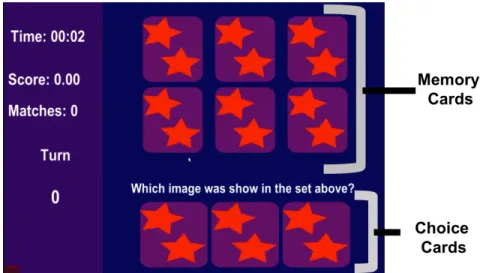
Evaluation
Participation
Participants who expressed interest via email or phone went through an initial screening phone call to ensure that they were able to perform basic computer tasks such as moving a mouse and clicking icons on a computer screen. For the study, participants came to our laboratory for a half hour to one hour session. Participants' ages ranged from 61 to 75 years (mean = 66.5), and 80 percent of participants identified as female and 20 percent identified as male.
90 percent of the participants expressed that they use their computer daily either for personal use or for work, yet many of them (70 percent) were not confident about their basic computer skills. 70 percent of participants use reminders or alarms to accomplish tasks, while 30 percent of participants expressed that reminders were never used in their daily lives to accomplish the task. Of the participants who use reminders, 90 percent indicated that they use them either once a week or daily to remember upcoming meetings, appointments, shopping lists, birthdays and as a wake-up alarm.
Protocol
We recruited ten older adults aged 60 years and older from the Nashville, Tennessee area using mass email distribution to people who had previously participated in research with our laboratory and expressed interest in being notified of other research opportunities, and we emailed also sent via various Vanderbilt University mailing lists. . Before participants pressed the Ready button, they had the opportunity to ask any clarifying questions. Each card was randomly generated from a list of 29 common pictures that older adults would recognize in everyday life (eg, cars, keys, TV, apple), see Figure III.3 for the full list of cards used.
Each participant had the same cards for a trial, but due to randomization, the locations of the memory cards and choice cards were different for each participant. At the end of the session, participants completed a postal survey to answer questions on the System Usability Scale (SUS) [35] and questions related to designing reminder systems for older adults.
Findings
Performance
- Level 1
- Level 2
- Level 3
The performance data within Level 1 show that five participants received a perfect score of five without receiving any prompts or extra chances to select the correct answer in a trial. For this research, perfect score refers to participants who did not receive prompts or extra chances to choose the correct answer. Participants who did not receive a perfect score in Level 1, four out of five participants received reminders.
If participants in Level 1 got a score less than three, they could try again at that level. No participants received an extra three for Level 1, meaning that all participants received a score of 3 or higher for Level 1. Among the seven participants without a perfect score, five participants were given extra chances to choose the correct answer.
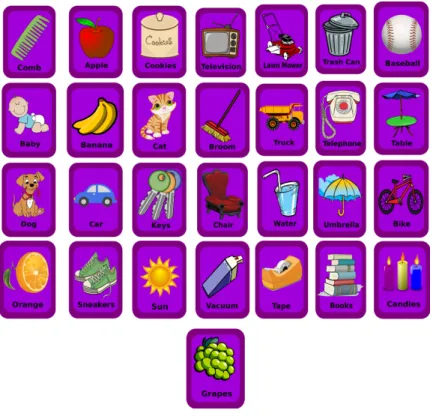
Attention
The viewing data in Figure III.9 that is boxed in red indicates that the participant viewed the memory box displayed in Figure III.10. With this data we can also see that some of the same patterns as the viewing data appear in many of the participants who did not get a perfect score, which is that the dots are more spread out with less eye movement occurring on the screen. .
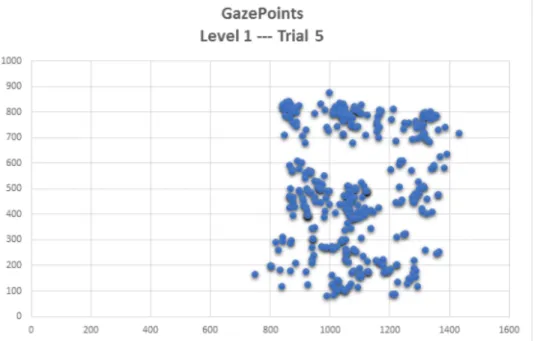
Post-Survey
- System Usability and Functionality
- Reminders Design
Participants who agreed to receive change mode reminders explained that “[I] have eye problems and it's easier [for me] to see changes in colors or positions than to have to read something”, others said that this will help them keep the reminder in their mind longer. 60 percent of older adults in this study stated that they would likely use reminder systems that allow users to look at the reminder to acknowledge it. Participants who responded likely to acknowledge reminders with eye movements felt that it would be something that was simple.
One participant who responded that he was less likely to use these types of reminders stated: “I already use visual reminders and I can ignore them or just click on them to make the reminder go away, [but] then [I do] DO NOT follow what the memory tells me to do.” Some participants went into more detail explaining a reminder system that “freezes the memories until you actually complete what the reminder tells you to do. [For example, with ] Fitbit – to take 250 steps, the visual reminder does not disappear. until the Fitbit tells the reminder that the task is complete.”. This information is useful for understanding the types of reminders that older adults might want to use in their daily lives.
Discussion
Older adults with AD who have visual impairments, such as low vision or have peripheral vision loss, may benefit from having reminders that change color and position when the reminder is not acknowledged. For example, if the reminder is for an appointment that is tomorrow, the reminder might appear yellow, meaning it needs attention, but if the appointment is today, the reminder might turn red, meaning it needs attention. need your attention now. Other features that would encourage attention to reminders would be to turn off or, in the words of one participant, “freeze” the screen, so the user is forced to attend to the reminder.
This would be important for older adults with AD to remember to take things like medications, exercise, stretch, and nutrition. When designing for older adults in general, it's important to keep things simple and functionality or physical interaction should be minimal. To do this, the system needs to learn the average time it takes the user to read and understand the tasks that are given, so the eye tracker tells the reminder to disappear after the reminder ends.
Conclusion/Future Work
Since older adults' memory isn't the only thing that sometimes begins to decline, vision and hearing do too, so design a system that can vary in sound or add a stronger vibration for older adults with AD who also have hearing impairments. Design specifications aimed at increasing the attention older adults give to reminders could include adding brighter colors or a color to rank the type of reminder. To do this, the system needs to learn the average time it takes the user to read and understand the tasks that were given, so the eye tracker tells the reminder to disappear after the reminder is completed. between the ages of 60 and 75 is the range where people begin to experience memory decline, and they experience normal age-related decline.
Also, because of the time constraint, it was more rewarding to test with healthy older adults. The next steps in this work will be to implement and test the reminder system using the design metrics described in this paper with older adults with early dementia or mild cognitive impairment. We will also close the system's loop to allow the eye tracker to 1) present reminders when attention is inactive and 2) allow the reminder to disappear by looking at the reminder.
Technical Contributions
Social Contributions
Self-management of chronic illness while living alone in later life: a systematic integrative review. Research on aging. Factors associated with depressive symptoms among older adults living alone: A gender difference analysis. Living alone and depressive symptoms: the influence of gender, physical disability, and social support among Hispanic and non-Hispanic older adults.
Singing for the brain': reflections on the human capacity for music emerging from a pilot study of group singing with Alzheimer's patients. Music improves category fluency in healthy older adults and patients with Alzheimer's disease. Experimental aging research. Electronic tracking system and wandering in Alzheimer's disease: a case study. Annals of physical and rehabilitation medicine.
